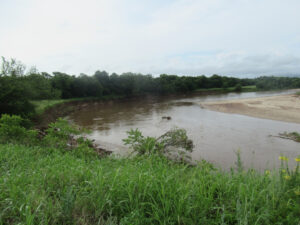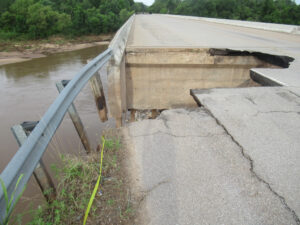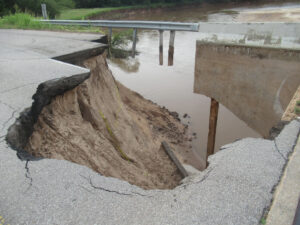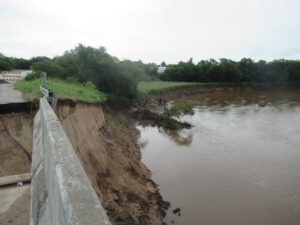This is the Britton Road bridge over the North Canadian River in eastern Oklahoma County. Just three weeks ago I visited this bridge over several days to cut the greenery intruding over the railing so cyclists could ride through safely on the shoulder.
 First, we look at how the river has been trying for several years now to change its course. The recent heavy rains and flash flooding have encouraged this trend. Thus, in this image was once a rather large acreage of livestock pasture, but the river has curved deep into that space. The bridge is off camera to my right. Ten years ago, the river ran almost straight under the bridge, what would be the far right edge of this image. It’s now nearly a quarter-mile east (left) of that original course.
First, we look at how the river has been trying for several years now to change its course. The recent heavy rains and flash flooding have encouraged this trend. Thus, in this image was once a rather large acreage of livestock pasture, but the river has curved deep into that space. The bridge is off camera to my right. Ten years ago, the river ran almost straight under the bridge, what would be the far right edge of this image. It’s now nearly a quarter-mile east (left) of that original course.
 Simply turning to my right and taking a few steps toward the bridge, the asphalt apron has collapsed because the ground underneath has washed away. The railing had been deeply planted in gravel and protected by rip-rap, but now hangs in the air. You can see the concrete pylon wall against which the dirt and rock were packed.
Simply turning to my right and taking a few steps toward the bridge, the asphalt apron has collapsed because the ground underneath has washed away. The railing had been deeply planted in gravel and protected by rip-rap, but now hangs in the air. You can see the concrete pylon wall against which the dirt and rock were packed.
 Viewed from the side, the big hole now looks right out into the water. Some of the apron surface is visible below, but the scope of what has washed away is easier to see. Keep in mind that the sloped bank was covered in tons of boulders as rip-rip, extending up to the pylon wall on which the bridge itself is resting. The actual bridge is just fine; it’s the apron that has been washed away.
Viewed from the side, the big hole now looks right out into the water. Some of the apron surface is visible below, but the scope of what has washed away is easier to see. Keep in mind that the sloped bank was covered in tons of boulders as rip-rip, extending up to the pylon wall on which the bridge itself is resting. The actual bridge is just fine; it’s the apron that has been washed away.
 Standing on the bridge itself and looking back upstream, there had been some twenty feet of dirt and rock protecting the roadbed, now washed away by the flash flooding. From what I understand, it was just a substantial surge of water some six feet deeper than the already swollen river visible in this picture.
Standing on the bridge itself and looking back upstream, there had been some twenty feet of dirt and rock protecting the roadbed, now washed away by the flash flooding. From what I understand, it was just a substantial surge of water some six feet deeper than the already swollen river visible in this picture.
We had two weeks of rain off and on. There is a massive high pressure dome south and west of Oklahoma, and a massive low pressure zone north and east. Between the two, unstable air was spun into the skies over Kansas, Oklahoma and northern Texas, and sweeping eastward into other states. It ran into the moisture blowing north from the Gulf of Mexico and produced storms. While the storms themselves were damaging enough, in our case the biggest problem has been the flash flooding. While it’s not quite the same as the damage from ten years ago, where I had to take a lot of detours on my country rides because just about every culvert was washed out, this is a major structure on a very busy thoroughfare that won’t be repaired easily. Between the city and county, they don’t even have the materials to fix this, and it will almost certainly be reviewed by the US Army Corps of Engineers before they can do anything.

